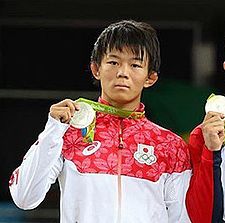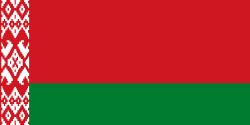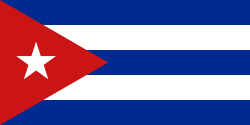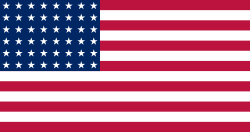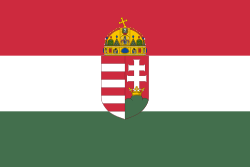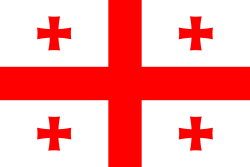Rei Higuči
| Rei Higuči | |
|---|---|
(c) Tasnim News Agency, CC BY 4.0 Rei Higuči s olympijskou medailí | |
| Osobní informace | |
| Datum narození | 28. ledna 1996 (28 let) |
| Místo narození | Ibaraki |
| Občanství | |
| Výška | 163 cm |
| Sportovní informace | |
| Sport | zápas |
| Disciplína | volný styl |
| Váhová kategorie | do 57 kg |
| Účast na LOH | 2016 |
| Některá data mohou pocházet z datové položky. | |
| Přehled medailí | ||
|---|---|---|
| zlato | LOH 2024 | volný styl do 57 kg |
| stříbro | LOH 2016 | volný styl do 57 kg |
Rei Higuči (japonsky 樋口黎, * 28. ledna 1996 Ibaraki) je japonský zápasník ve volném stylu. Studuje Nippon Sport Science University. V roce 2012 vyhrál mistrovství Asie v kategorii kadetů, v roce 2015 se stal mistrem Japonska a v březnu 2016 vyhrál asijský kvalifikační turnaj na olympiádu v nejlehčí váhové kategorii. Na olympiádě nepatřil k favoritům nejlehčí váhové kategorie,[1] ale dokázal projít až do finále, kde podlehl úřadujícímu mistru světa Vladimeru Chinčegašvilimu, ačkoli vedl už 3:0, a získal stříbrnou medaili.[2]
Olympijské výsledky
 Jang Kjong-il 12:2
Jang Kjong-il 12:2 Asadulla Lačinov 10:0
Asadulla Lačinov 10:0 Yowlys Bonne 8:4
Yowlys Bonne 8:4 Hasan Rahímí 10:5
Hasan Rahímí 10:5 Vladimer Chinčegašvili 3:4
Vladimer Chinčegašvili 3:4
Reference
- ↑ United World Wrestling
- ↑ Higuchi battles to silver medal in 57-kg wrestling. Japan Times. www.japantimes.co.jp [online]. [cit. 2017-01-17]. Dostupné v archivu pořízeném z originálu dne 2016-08-20.
Externí odkazy
 Obrázky, zvuky či videa k tématu Rei Higuči na Wikimedia Commons
Obrázky, zvuky či videa k tématu Rei Higuči na Wikimedia Commons - Rei Higuči v databázi Olympedia (anglicky)
- International Wrestling Database
Média použitá na této stránce
Olympic Rings without "rims" (gaps between the rings), As used, eg. in the logos of the 2008 and 2016 Olympics. The colour scheme applied here was specified in 2023 guidelines.
Olympic Rings without "rims" (gaps between the rings), As used, eg. in the logos of the 2008 and 2016 Olympics. The colour scheme applied here was specified in 2023 guidelines.
Flag of Iran. The tricolor flag was introduced in 1906, but after the Islamic Revolution of 1979 the Arabic words 'Allahu akbar' ('God is great'), written in the Kufic script of the Qur'an and repeated 22 times, were added to the red and green strips where they border the white central strip and in the middle is the emblem of Iran (which is a stylized Persian alphabet of the Arabic word Allah ("God")).
The official ISIRI standard (translation at FotW) gives two slightly different methods of construction for the flag: a compass-and-straightedge construction used for File:Flag of Iran (official).svg, and a "simplified" construction sheet with rational numbers used for this file.
Georgian flag in Pantone MS.
US Flag with 45 stars. In use 4 July 1896–3 July 1908. Created by jacobolus using Adobe Illustrator, and released into the public domain. This flag was used during the Spanish-American War.
US Flag with 45 stars. In use 4 July 1896–3 July 1908. Created by jacobolus using Adobe Illustrator, and released into the public domain. This flag was used during the Spanish-American War.
Finská vlajka
US Flag with 48 stars. In use for 47 years from July 4, 1912, to July 3, 1959.
Flag of Hungary, from 6 November 1915 to 29 November 1918 and from August 1919 until mid/late 1946.
Variant version of a flag of Japan, used between January 27, 1870 and August 13, 1999 (aspect ratio 7:10).
(c) I, Cmapm, CC BY-SA 3.0
The flag of the Soviet Union (1955-1991) using a darker shade of red.
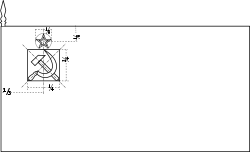
(c) I, Cmapm, CC BY-SA 3.0
The flag of the Soviet Union (1955-1991) using a darker shade of red.

(c) Tasnim News Agency, CC BY 4.0
2016 Summer Olympics, Men's Freestile Wrestling 57 kg. Podium.
Russian Olympic Committee flag used in 2020 and 2022, for the Olympics
